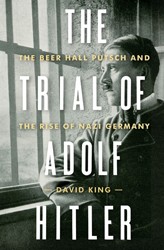In his latest book, public intellectual and historian Michael Brenner focuses on Weimar Munich to draw out the essential characteristics of Hitler’s rise and appeal, the germs of Nazism, the social context of a revolutionary time, and how the seeds of antisemitism fell on fertile ground. He looks at how Munich, in the oft-quoted words of Thomas Mann, became the “city of Hitler.”
Brenner weaves together social and cultural analysis with illustrative and detailed descriptions of the individuals and incidents that when taken together led to the unimagined catastrophe of the Shoah. He uses many hitherto unexamined documents to show how an apparently sophisticated and cosmopolitan city became the testing ground of Hitler’s politics, and how, in the aftermath of the failed revolution of 1918 – 19 and the establishment of a right-wing government in Bavaria that linked the leftists and Jews in a conspiratorial soup, so many acquiesced, turned a blind eye, partied on, or simply did nothing, if they did not actively collaborate. However, Brenner argues that the Jewish leftists in Munich had a stronger relationship to their Jewishness than, for example, Rosa Luxemburg in Berlin, or Trotsky, or Bela Kun. For people like Kurt Eisner and Gustav Landauer, a close friend of Martin Buber, being Jewish meant something, much to their cost.
Brenner’s discussion of the response of Munich’s Jewish population is especially interesting: to oppose, to fight, to hide, to ignore, to run, or indeed, to support the right, if not the Nazis, as many did. These are some of the impossible choices that people were forced to make. Was the writing on the wall or would it all be over in a matter of months, and was this Hitler character just a blow-hard or a danger to the Jewish people unlike anything encountered before? Brenner’s nuanced account sees the logic of each choice, even if some were tragically mistaken, and argues that the Jews of Munich were the first victims of the horrors that were to engulf the world over the next twenty years.
Brenner’s scholarship is rigorous and impressive, but he can also write poignantly, as in the final chapter, in which he looks at how the events he describes have been remembered over time, and takes us on a short tour of the New Israelite Cemetery in Munich examining the gravestones: Sonja Lerch, who took her own life in Stadelheim prison in 1918; Eugen Levine, executed in the same prison in 1919 Kurt Eisner, assassinated in 1919; and Gustav Landauer, kicked to death by prison guards in 1919 sharing the same marker. Brenner never lets us forget that these were people, not just figures in a historical text.
In the preface, Brenner makes a remarkable statement that resonates all the way through the book. He notes that although he did not intend or foresee it when he began to write, it quickly became apparent to him that what he was describing resonated uncomfortably with the events of January 6th, 2020 — the storming of the Capitol in Washington. At every turn the reader is reminded of the lessons of history.
Brenner puts Hitler’s antisemitism at the forefront of a political strategy; it is a tool as much as a core stance. Hitler recognizes its galvanizing effect. Again, Brenner hears the echoes of 2021: the demagoguery, the bullying, the vicious ad hominem attacks, and how useful it is to find a focus into which to channel anger.
As Brenner has said, it is not entirely coincidental that the book comes out a hundred years after the events in Munich, events that carry a lesson for us today. What have we learned? That is one of the challenges he lays down for the reader.




